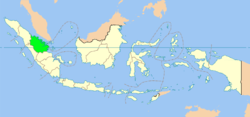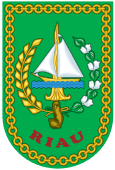Riau
| Riau Riau | |||||
|---|---|---|---|---|---|
| Province | |||||
| Other transcription(s) | |||||
| • Jawi | رياو | ||||
| • Chinese | 廖内 | ||||
From top, left to right: Siak Palace, Tengku Agung Sultanah Latifah bridge, An-Nur Mosque | |||||
| |||||
|
Motto: Bumi Bertuah Negeri Beradat (Malay) (Ground of Fortunes, Land of Customs) | |||||
 Location of Riau in Indonesia | |||||
| Coordinates: 0°32′N 101°27′E / 0.533°N 101.450°ECoordinates: 0°32′N 101°27′E / 0.533°N 101.450°E | |||||
| Country |
| ||||
| Established | August 10, 1957 | ||||
| Capital |
| ||||
| Government | |||||
| • Body | Riau Regional Government | ||||
| • Governor | Arsyadjuliandi Rachman (Golkar) | ||||
| • Vice-governor | Vacant | ||||
| Area | |||||
| • Total | 87,023.66 km2 (33,600.02 sq mi) | ||||
| Area rank | 7th | ||||
| Elevation | 10 m (30 ft) | ||||
| Highest elevation | 1,091 m (3,579 ft) | ||||
| Lowest elevation | 0 m (0 ft) | ||||
| Population (2015)[1] | |||||
| • Total | 6,344,402 | ||||
| • Rank | 10th | ||||
| • Density | 73/km2 (190/sq mi) | ||||
| • Density rank | 24th | ||||
| Demonym(s) |
Riauan Warga Riau (id) Kaum Riau (ms) | ||||
| Demographics | |||||
| • Ethnic groups | Malay (33.28%), Javanese (29.20%), Batak (12.55%), Minangkabau (12.29%), Banjar (4.13%)[2] | ||||
| • Religion | Islam (89.27%), Protestantism (7.87%), Buddhism (1.84%), Roman Catholicism (1.06%), Confucianism (0.08%), Hinduism (0.07%) | ||||
| • Languages |
Indonesian (official) Malay, Minangkabau, Hokkien (regional) | ||||
| Time zone | Indonesia Western Time (UTC+7) | ||||
| Postcodes | 28xxx, 29xxx | ||||
| Area codes | (62)6xx, (62)76x | ||||
| ISO 3166 code | ID-RI | ||||
| Vehicle sign | BM | ||||
| GRP per capita | US$ 9,252.17 | ||||
| GRP rank | 3rd | ||||
| HDI |
| ||||
| HDI rank | 6th (2015) | ||||
| Largest city by area | Dumai - 1,623.38 square kilometres (626.79 sq mi) | ||||
| Largest city by population | Pekanbaru - (929,247 - 2015) | ||||
| Largest regency by area | Indragiri Hilir Regency - 11,605.97 square kilometres (4,481.09 sq mi) | ||||
| Largest regency by population | Kampar Regency - (711,236 - 2015) | ||||
| Website | Government official site | ||||
Riau (Jawi: رياو, Chinese: 廖内; pinyin: Liào nèi), is a province of Indonesia. It is located in the central eastern coast of Sumatra along the Strait of Malacca. Until 2004 the province included the offshore Riau Islands, a large group of small islands (of which the principal islands are Batam and Bintan) located east of Sumatra Island and south of Singapore, before these islands were split off as Riau Islands Province in July 2004. The provincial capital of Riau Province and its largest city is Pekanbaru. Other major cities include Dumai, Selat Panjang, Bagansiapiapi, Bengkalis, Bangkinang, Rengat and Siak Sri Indrapura.
Riau is currently one of the richest provinces in Indonesia and is rich in natural resources, particularly petroleum, natural gas, rubber, palm oil and fibre plantations. Extensive logging and plantation development in has led to a massive decline in forest cover Riau, and associated fires have contributed to haze across the larger region.
Since the 1970s, much of Indonesia has experienced a decline in population growth rates. Riau has been a significant exception, with increasing rates every decade since 1970 to a 4.35 percent annual rise for the 1990s;[3] however, this rate slowed significantly during the subsequent decade. The provincial population was 5,538,367 at the 2010 census.[4] and according to the estimate for January 2014 this had risen to 6,358,636.
History
Previously Riau Province was a part of Central Sumatra Province with Bukittinggi as its capital, but in January the rebellion of Dewan Banteng occupied Riau on 1 January 1957 and on 9 August 1957 President Soekarno declared Riau Province.[5]
Language
Riau Province is home to various dialects of the Malay and Chinese language. The dominant language used by the Malay population is Malay. The Chinese population (predominantly Hokkien) speak a variety of Chinese dialects, the most common being Min Nan, originating from the southern part of Fujian province in the south-eastern part of China. Present-day inhabitants are migrants from other provinces, speaking a variety of languages, mostly Minangkabau as well as Javanese.
Riau Malay
The dialect of Malay spoken in Riau Province is considered by linguists to have one of the least complex grammars among the languages of the world, apart from creoles, possessing neither noun declensions, temporal distinctions, subject/object distinctions, nor singular/plural distinction. For example, the phrase Ayam makan (lit. 'chicken eat') can mean, in context, anything from 'the chicken is eating', to 'I ate some chicken', 'the chicken that is eating' and 'when we were eating chicken'. The traditional script in Riau is Jawi (locally known in Indonesia as "Arab-Melayu"), an Arabic-based writing in the Malay language.[6] A possible reason for this is that Riau Malay has been used as a lingua franca for communication between different people in this area during its history, and extensive foreign-language speaker use of this kind tends to simplify the grammar of a language used.[7]
It is sometimes supposed that Riau Malay is the basis for the modern national language, Indonesian. However, it is instead based on Classical Malay, the court language of Johor-Riau Sultanate, based primarily from the one used in the Riau archipelago and the state of Johor, Malaysia, which is distinct from the local mainland Riau dialect.[8]
Non-mainstream varieties in Riau include Orang Sakai, Orang Asli, Orang Akit, and Orang Laut.[9]
Riau Minangkabau
Minangkabau language is the indigenous language of the western part of Riau, mainly in the Pekanbaru, Kampar, Kuantan, and Rokan Hulu.[10] The pronunciation of Riau Minangkabau similar to Payakumbuh-Batusangkar dialect, even differs from that of other dialects varieties of West Sumatra. Historically, Minangkabau language used in the Sultanate of Siak and nowadays also spoken in the lower Siak river basin.
Administrative divisions
| Historical population | ||
|---|---|---|
| Year | Pop. | ±% |
| 1971 | 1,641,545 | — |
| 1980 | 2,168,535 | +32.1% |
| 1990 | 3,303,976 | +52.4% |
| 1995 | 3,900,534 | +18.1% |
| 2000 | 4,957,627 | +27.1% |
| 2010 | 5,538,367 | +11.7% |
| 2014 | 6,358,636 | +14.8% |
| sources:[11][12] Note: Census years not equidistant, 2010 excludes Riau Islands split. | ||
Riau Province is subdivided into ten regencies (kabupaten) and two autonomous cities (kota), listed below with their areas and their populations at the 2010 Census and according to the latest (January 2014) estimates.
| Name | Area (km2) | Population Census 2010 | Population Estimate 2014 | Capital |
|---|---|---|---|---|
| Dumai City | 1623.38 | 253,803 | 291,393 | Dumai |
| Pekanbaru City | 632.27 | 897,767 | 1,030,732 | Pekanbaru |
| Bengkalis Regency | 6,976.41 | 498,336 | 572,143 | Bengkalis |
| Indragiri Hulu Regency | 7,723.80 | 363,442 | 417,270 | Rengat |
| Indragiri Hilir Regency | 12,614.78 | 661,779 | 759,793 | Tembilahan |
| Kampar Regency | 10,983.47 | 688,204 | 790,132 | Bangkinang |
| Kepulauan Meranti Regency (Meranti Islands) | 3,707.84 | 176,290 | 202,400 | Selat Panjang |
| Kuantan Singingi Regency | 5,259.36 | 292,116 | 335,380 | Teluk Kuantan |
| Pelalawan Regency | 12,758.45 | 301,829 | 346,532 | Pangkalan Kerinci |
| Rokan Hulu Regency | 7,588.13 | 474,843 | 545,170 | Pasir Pangaraian |
| Rokan Hilir Regency | 8,851.59 | 553,216 | 635,151 | Bagansiapiapi |
| Siak Regency | 8,275.18 | 376,742 | 432,540 | Siak Sri Indrapura |
Economy
The economy of Riau expands faster (8.66% in 2006) than the Indonesian average (6.04% in 2006), and is largely a resource-based economy, including crude oil (600,000 bpd), palm oil, rubber trees and other forest products. Local government income benefits from a greater share of tax revenue (mainly from crude oil) due to the decentralisation law of 2004.[13]
Ecology
Forest cover in Riau has declined from 78% in 1982 to only 33% in 2005.[14] This has been further reduced an average of 160,000 hectares on average per year, leaving 22%, or 2.45 million hectares left as of 2009.[15] Fires associated with deforestation have contributed to serious haze over the province and cities to the East, such as Singapore and Kuala Lumpur, Malaysia [16][17] .

Giam Siak Kecil – Bukit Batu Biosphere Reserve, Indonesia, is a peatland area in Sumatra featuring sustainable timber production and two wildlife reserves, which are home to the Sumatran tiger, Sumatran elephant, Malayan tapir, and Malayan sun bear. Research activities in the biosphere include the monitoring of flagship species and in-depth study on peatland ecology. Initial studies indicate a real potential for sustainable economic development using native flora and fauna for the economic benefit of local inhabitants.
Cagar Biosfer Giam Siak Kecil Bukit Batu (CB-GSK-BB) is one of seven Biosphere Reserves in Indonesia. They are located in two areas of Riau Province, Bengkalis and Siak. CB-GSK-BB is a trial presented by Riau at the 21st Session of the International Coordinating Council of Man and the Biosphere (UNESCO) in Jeju, South Korea, on 26 May 2009. CB-GSK-BB is one of 22 proposed locations in 17 countries accepted as reserves for the year. A Biosphere Reserve is the only internationally recognised concept of environmental conservation and cultivation. Thus the supervision and development of CB-GSK-BB is a worldwide concern at a regional level.
CB-GSK-BB is a unique type of Peat Swamp Forest in the Kampar Peninsula Peat Forest (with a small area of swamp). Another peculiarity is that the CB-GSK-BB was initiated by private parties in co-operation with the government through BBKSDA (The Center for the Conservation of Natural Resources), including the notorious conglomerate involved in forest destruction, Sinar Mas Group, owning the largest paper and pulp company in Indonesia.
Sports
Riau has a football team, PSPS Pekanbaru, based in Kaharuddin Nasution Stadium, Pekanbaru. There is football team PS Siak too. In 2012, Riau hosted Pekan Olahraga Nasional.
See also
References
- ↑ "Provinsi Riau Dalam Angka 2016" (PDF) (in Indonesian). Retrieved 2016-09-22.
- ↑ Aris Ananta; Evi Nurvidya Arifin; M. Sairi Hasbullah; Nur Budi Handayani; Agus Pramono (2015). Demography of Indonesia’s Ethnicity. Institute of Southeast Asian Studies dan BPS – Statistics Indonesia.
- ↑ BPS:Laju Pertumbuhan Penduduk menurut Provinsi
- ↑ Central Bureau of Statistics: Census 2010, retrieved 17 January 2011 (Indonesian)
- ↑ "Inilah Sejarah Terbentuknya Provinsi Riau". 10 August 2014.
- ↑ Gil, David (2008). Miestamo, Matti; Sinnemäki, Kaius; Karlsson, Fred, eds. How complex are isolating languages?. Language complexity: Typology, contact, change (Studies in Language Companion Series 94). Amsterdam: Benjamins. pp. 109–131.
- ↑ McWhorter, John (2001). "The world's simplest grammars are creole grammars". Linguistic Typology. Walter de Gruyter. 5 (2001): 125–166. doi:10.1515/lity.2001.001.
- ↑ Sneddon 2003, The Indonesian Language: Its History and Role in Modern Society, p. 70
- ↑ "Dept. of Linguistics | Linguistic Field Work in Riau Province, Indonesia". Eva.mpg.de.
- ↑ Bambang Kaswanti Purwo; Kajian Serba Linguistik: untuk Anton Moeliono, Pereksa Bahasa; BPK Gunung Mulia, 2000
- ↑ "Statistics Indonesia". Bps.go.id.
- ↑ http://www.depkes.go.id/downloads/Penduduk%20Kab%20Kota%20Umur%20Tunggal%202014.pdf Estimasi Penduduk Menurut Umur Tunggal Dan Jenis Kelamin 2014 Kementerian Kesehatan
- ↑ Riau, Provinsi yang Maju Pesat
- ↑ WWF:The Eleventh Hour for Riau's Forests
- ↑ "Logging moratorium 'a must' to save Riau forests". The Jakarta Post. 16 May 2009.
- ↑ "'Indonesian'-made haze covers parts of KL, surrounding areas". The Jakarta Post. 16 June 2012.
- ↑ http://www.bernama.com/bernama/v6/newsindex.php?id=673630
Template:Indonesia
.jpg)




